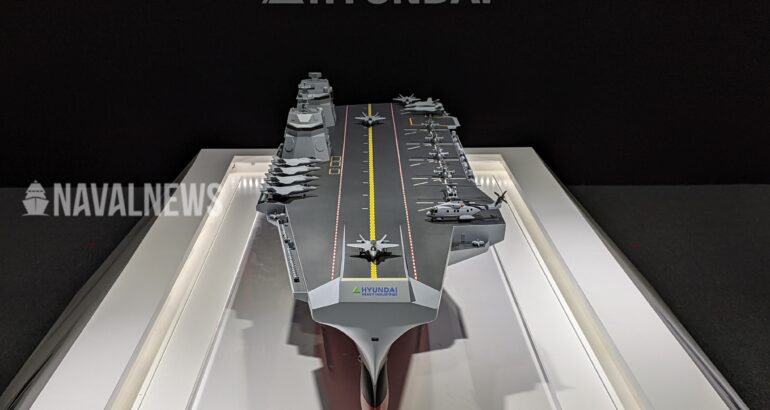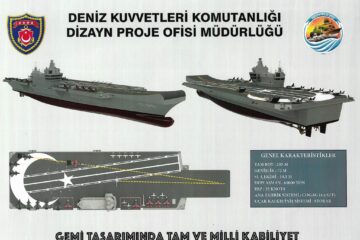The new design has an empty displacement of 30,000 tons. Despite this, the ship is 60 meters in width, 270 meters in length and has a 260 meter flight deck. This means that it is significantly longer than, but has a similar displacement to, previous designs.
“We can keep the displacement low because we redesigned the lower part of the ship. Our previous version has a thicker hull,” said an HHI representative who was interviewed by Naval News.

“This does sacrifice internal capacity somewhat. However, the negative effects are more than made up for by the increased length, as well as, the speed and stability that we gain from the design.”
Like the previous design, the ship is capable of carrying 16-20 F-35B fighters, as well as helicopters. “We’re still able to easily alter the flight complement to carry out amphibious assault operations. We can fit more than thirty helicopters if we need to.”
The ship features twin islands and two aircraft elevators on either side of the flight deck. The first island will be in charge of overall operations, while the second island will carry out flight control duties. Moreover, the X-shaped design of the new islands provide unique advantages according to the representative.

“They provide a significant degree of stealth, reducing the ship’s overall radar cross section. It also allows us to install the ship’s AESA radar lower down on the island. This is because the part of the island where the radar will be installed is slanted, meaning that the radar will not be hampered by clutter from flight operations. This frees more room for a multitude of sensors on top of the island,” the representative explained.
According to him, the design allows for more efficient flight control as well. “Flight control makes up the upper X shape, which means flight control operators have great visibility of the flight deck”.
Another interesting feature of the HHI design is the focus on unmanned systems. The new design was built with the operation of such systems in mind from the very outset.
The stern area features a special flight deck for unmanned aerial vehicles (UAV) that take off vertically. There are 16 KVLS cells next to the UAV flight deck. The ship also has a mini-well deck for unmanned underwater vehicle and unmanned surface vehicle operations.
The most eye-catching new feature of this design is the ski-jump. “We tried to take onboard the domestic criticism regarding the light aircraft carrier design,” explained the representative, referring to the recent controversy that has been generated by the CVX program.
The ski-jump allows the F-35B to take off more easily while fully-loaded. The representative told us that this will lead to higher sortie rates. “Sortie rates depend on many variables, such as wind, humidity etc. Having a ski-jump allows us to be influenced less by these conditions when it comes to flight operations.” Moreover, the ski-jump coupled with the long flight deck allows the carrier to be easily converted for short take off but arrested recovery (STOBAR) operations.

“We built in growth potential from the very beginning. If we install an angled flight deck and arresting wire for when aircraft land, the ship can be configured for STOBAR”.
Despite this, the representative emphasized that a conversion to catapult assisted take off but arrested recovery (CATOBAR) would be difficult. “The catapult system requires a lot of energy to operate, so without a major overhaul of the propulsion system itself, conversion to CATOBAR is unlikely.”
Some claim it is unclear whether a ski-jump is the optimal design for higher sortie rates. “We are also conducting research on adding a ski-jump, although that is not currently in the Republic of Korea Navy (ROKN)’s operational requirements,” a DSME representative told Naval News.

According to him, the primary advantage of the ski-jump is that it allows F-35Bs to take off while using less of the runway. “However, this does not necessarily translate to higher sortie rates because the addition of the ski-jump would make the flight deck more congested,” explained the representative. “More research will have to be done to see which one is the most efficient design. We are ready to change the design if operational requirements change.”
Our video coverage of HHI’s CVX at MADEX 2021:








